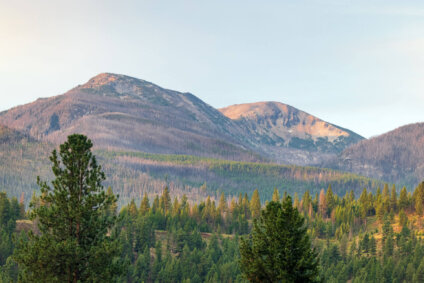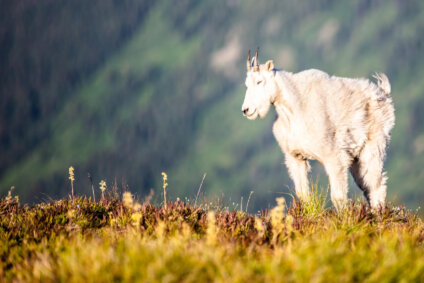Saving the Great Burn from Irrevocable Change
Two forest plans, one imminent, will determine the fate of one of the wildest places in the Lower 48

Haggard and ragged, I dropped my unwieldy pack on the lake’s edge. My throat screamed with thirst and my arms bled from a dozen fresh cuts after an unseasonably warm autumn bushwhack. Still, I could not help but smile broadly. The scratches were a small price to pay for entry into an idyllic mountain cirque. Save for the outlet where I had entered, the small lake was perfectly enclosed on all sides by an 800-foot wall of rock and snow. A meandering stream cut a quiet path through a subalpine meadow between the lake and the rock wall. Large permanent snowfields (there must be wolverines here!) gave shape to the southeast portion of the cirque. The basin lacked any signs of previous human presence: no trails, no campsites, no footprints. The only notable infrastructure was that of the beasts. Game trails. Everywhere. Nearing the end of my initial scan of the wall, I noticed movement in the meadow. Elk.
I awoke the next morning to a small herd of mountain goats traipsing along the cliff bands of the cirque, engaged in their delicate, but deliberate gastronomic acrobatics. This place! After a sunrise photoshoot and a ramble around the top of the cirque, I broke camp and retraced my mile-long route back to the trail. That’s right, this mountain paradise, the likes of which I’d put up against the Canadian Rockies and areas of the Himalayas in terms of pure wildness, lies a mere mile (a hard-fought mile) from the nearest trail. And that’s the Great Burn: rugged, verdant, and as wild as they come. Yet, it remains a lower-case wilderness, without permanent protections, and subject to the whims of Forest Service employees.

The word Wilderness, in its earliest origins, meant ‘the place of the wild beasts.” We ourselves were included in the Wilderness Act as a different sort of beast, one with temporary and low-impact access to lands designated as Wilderness. We should count ourselves fortunate to walk the same trails as the mountain goat, moose, and grizzly. That a mountain lion might witness us unseen is awesome, too. The Wilderness, free of permanent humans and their machines, is its home. These tracts of unbroken ecosystems – roadless and ecologically vital – are critical to the maintenance of a healthy planet: a place where flora and fauna can cultivate balance that supports healthy water and air for us, the other beasts.
The story of the Great Burn’s struggle to achieve upper-case Wilderness status is a legendary one. Filled with tales of intrepid conservationists dedicating their lives to its protection, the Great Burn has lived on the precipice of Wilderness designation for nearly the entire sixty years the Wilderness Act has been around. Taken together, the two forest planning processes addressing the Great Burn – that of the Nez-Perce Clearwater on the Idaho side and the Lolo on the Montana side – hold the future of the Great Burn in the balance by determining whether it will continue to be managed to maintain its wilderness character. With the release of the Nez Perce-Clearwater draft management plan and the imminent release of the Lolo management plan, we find ourselves at an inflection point that will determine the fate of the Great Burn.

If machines and technology are our future, then future generations, more than ever, will need non-motorized tracts of land where they can catch their breath and connect to something greater than their handheld computers. That 40,000 acres include deep winter subalpine habitat that is critical for wolverines, now listed as threatened under the Endangered Species Act, and for mountain goats, also a species in peril. Disruptions from loud, fast-moving machines during the hungry months of winter puts these species at risk of survival. Every step we make that erodes the web of life is almost always irreversible. Our great grandchildren will not thank us.
We now have an opportunity now to take action. We can call on the Forest Service to continue managing this wild, high-elevation place as recommended Wilderness, as the agency has done for the past 35 years. We can contribute our voices, asking the Nez Perce-Clearwater forest supervisor and biologists to maintain protection of this area, increase snowmobiler education on boundaries, and increase patrols/monitoring of illegal snowmobiling activity. There are plenty of wonderful places to snowmobile around the region: let’s leave this one alone.
Contribute your voice by commenting on the Nez Perce-Clearwater Forest Plan before Monday, Jan. 29, and stay tuned for how to get involved with the Lolo Forest Plan. Let’s save the Great Burn, its wolverines and mountain goats, and our present and future potential for solitude. We should hope that in two hundred years’ time our descendants can wander into a secluded subalpine basin, pitch a tent, and drift off to the sound of a bulging elk.
Stand up for the Great Burn
We urgently need your help protecting the Great Burn, one of the Lower 48’s wildest roadless areas. The draft final plan for the Nez Perce-Clearwater Forest proposes opening up over 40,000 acres of crucial wildlife habitat to snowmobiling and mountain biking. It’s critical that you submit an objection to the latest version by Monday, Jan. 29

Stay Connected
"(Required)" indicates required fields


